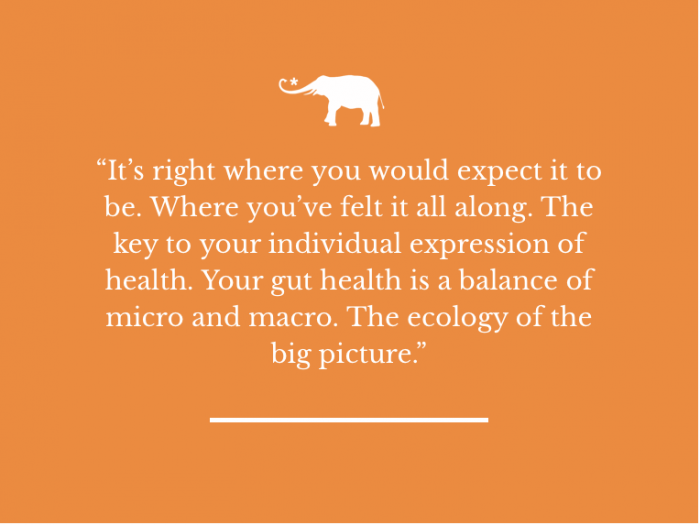By now, many of us are aware that we have a “second brain”. For the rest of us shyly scratching our heads, it’s okay – it’s not something anatomists openly talk about.
UNTIL NOW.
The second brain has been danced around for centuries; however, recent (the last 50 years) research is finally shining the light more confidently in it’s direction. It’s finally not only “safe” to talk about, but it’s changing body-mind medicine, and in turn: Lives. Now that we’ve established that it’s safe to talk about, let’s give it a name: “The Enteric Nervous System.” If you’re still scratching your head, don’t. Rub your belly (or do both at the same time – that’s always a good skill to practice). Why? Because that’s where you’ll find the bulk of it. Your second brain is your GUT. And fortunately for the uncoordinated lot of us, we don’t have to try to connect the two computing systems, they’re already in communication via a bi-directional messaging system – also known as the Vagus Nerve.
A FEW INTERESTING FACTS, HERE.
- Did you know that your enteric nervous system has more nerve endings than your spinal chord? (100 million nerve endings)
- Ninety percent (90%) of serotonin is made in the gut. Serotonin is the key neurotransmitter which stabilizes our feelings of well-being and happiness, mood, and helps the nervous system cells communicate to regulate sleeping, eating and digestion.
- Our gut not only has a mind of its own, but it has an ecosystem of its own.
When the Human Genome Project was first launched, the purpose was to sequence all the genes found in humans, with the goal of accurately sequencing 3 billion nucleotide base pairs in the genome. That was back in 2003. Since then, we’ve learned that only 0.5% of that massive genome is unique to an individual. As healthcare providers, when a patient asks us “Why is this thing growing on me” or “Why am I losing my hair in this pattern?” we are trained and conditioned to offer a few solutions and causes. When all other readily available options have been exhausted, one of our final counseling points may align with the statement “It’s in your genes.”
BUT LET’S RECAP: “ONLY 0.5% OF THAT MASSIVE GENOME IS UNIQUE TO AN INDIVIDUAL.”
Now, let’s get curious. If 95.5% of our genes are the same, how do we look so different? How do our bodies function and express so variably? How do we think and feel at such an array of extremes from person to person? How are some of us able bodied and others dealing with visible and invisible handicaps? With what seems like such a narrow margin of gene variability, how are so many unlike outcomes produced? The simple answer lies in gene expression. That has to do with genes being turned on / off / suppressing other genes, etc. It has to do with environmental exposures, external influences of stress which could come from the individual’s physical setting or a cascade of stress hormones influenced by perceptions of the mind. It has to do with internal influences strongly related to diet, sleep patterns, inflammation, hydration, etc. That’s the simple answer. Science is taking it a step further than the human genome. The much larger and often ignored overlay to that blueprint, the human microbiome, contains genetic information which dwarfs as well as influences our own gene expression at a rate of 360 bacterial genes to our 1 gene (NIH, 2012). It’s safe to say that more than half of our actual bodies are not human.
WHAT DOES THIS HAVE TO DO WITH THE “SECOND BRAIN”?
Because of the close relationship between the gut and the brain (the gut-brain axis), which is bi-directional, meaning: your thoughts and feelings influence your gut health, which translates to digestion, effective absorption, immune response, energy uptake, etc. AND your gut health influences availability and activity of neurotransmitters and activity of signalling pathways, the way you feel, and in turn, your outlook and how you face the world…
Your Gut Microbiome
Is an equally important part of this same axis (now called the gut-brain-microbiome axis). Your microbiome is one of the most important co-managers of your health, equal in power to the lifestyle decisions you make on a regular basis.When your gut is in dysbiosis and imbalance, you are more prone to depression, mental / cognitive decline, in addition to conditions such as Irritable Bowel Syndrome (IBS), Colitis, and leaky gut. Needless to say, this can become a vicious cycle, which is why these conditions (both mental and physical) are labeled and treated as chronic illnesses.
BUT WAIT. AREN’T WE DYNAMIC HUMAN BEINGS?
Isn’t it true that we are co-creators in our own realities? Isn’t it a fact that we shed our entire outer layer of skin every 2-4 weeks? Isn’t it remarkable that the adult skeleton is remodeled and replaced every 10 years?
DOES OUR GUT DO THAT TOO?
If you’re asking, I’ll tell you. We shed our gut lining every 5-7 days. It’s the most rapidly regenerating epithelium in the body. What does that tell you? Does that tell you that there’s a chance that you could treat, heal, regenerate, and restore your gut? If you agreed with that thought process, you’d be in alliance with the rapidly growing number of Functional and Integrative Medicine doctors and practitioners.
WHY IS THAT IMPORTANT?
In taking accountability for your lifestyle choices and well being, you may not have to be the victim of a chronic illness and you have more than one approach accessible to nourish your mental health.
STAY TUNED FOR OUR UPCOMING BLOG POST, WHERE I’LL SHARE MY TOP TIPS FOR MINDING YOUR MICROBIOME AND HEALING YOUR GUT.
Gut Healthy to Get Healthy,
Nicole Gentile, MMS, PA-C
Co-founder Aesthetix Skin & SurgeryCEO of Elemental Healing Solutions












Read 4 comments and reply